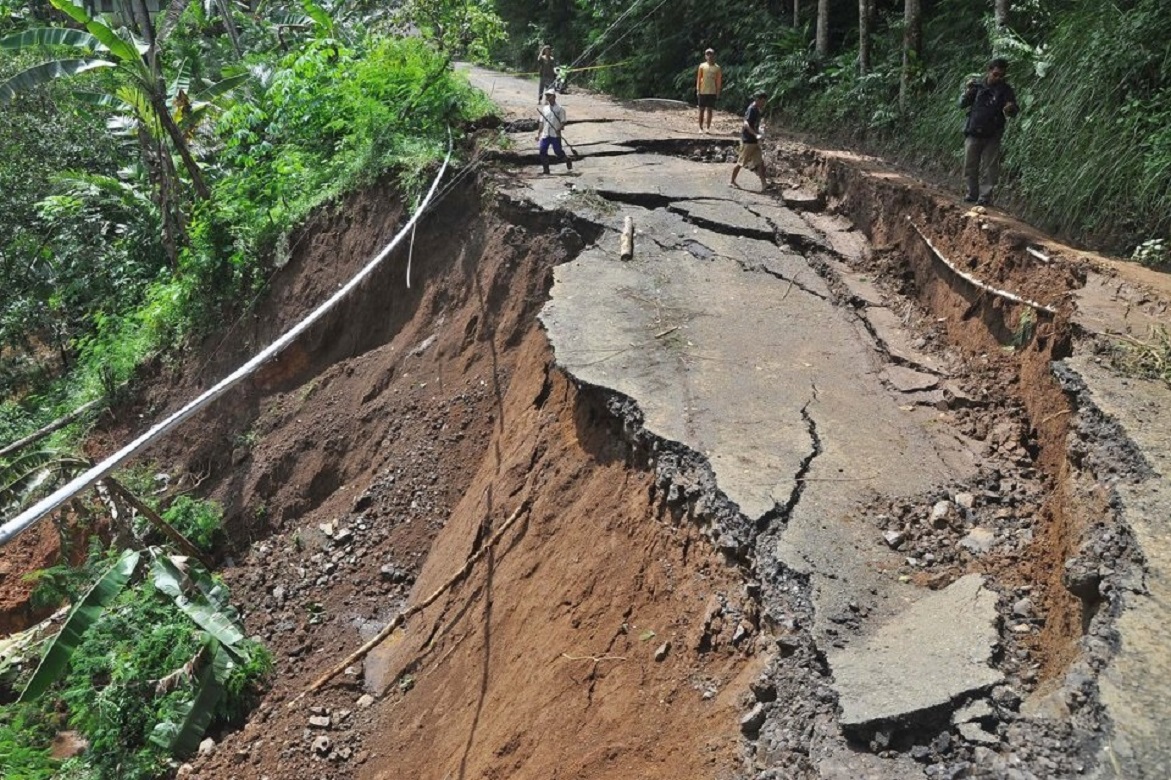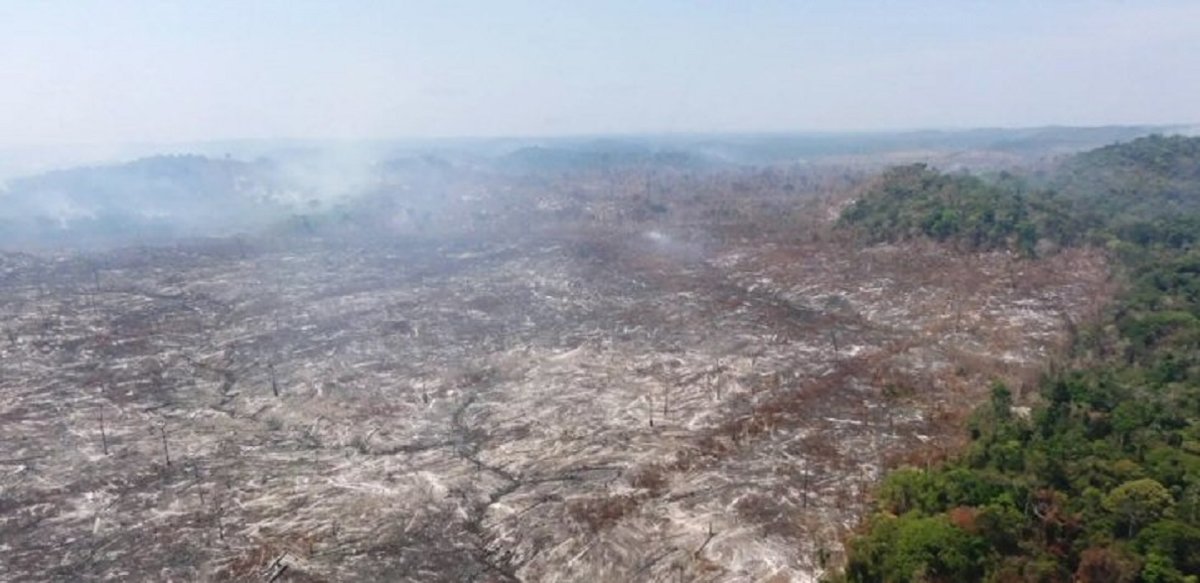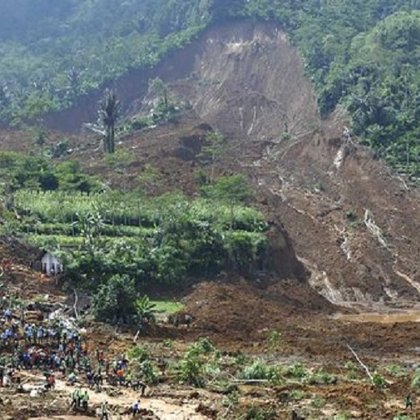EROSION IS THE PROCESS BY WHICH THE SURFACE OF THE EARTH GETS WORN DOWN.EROSION CAN BE CAUSED NATURAL ELEMENTS,MOVING WATER,WIND ,GRAVITY AND ICE WEAR AWAY OR BREAK AWAY,SEDIMENTS AND SOIL FROM THE LAND'S SURFACE.RAINFALL ALSO CAUSED EROSION.THESE EROSION HAPPEN TO OFTEN IN WORLD'S TROPICAL /RAIN FORESTS LIKE IN INDONESIA.
 Rainfall may also move soil indirectly, by means of runoff in rills gullies larger channels, too big to be removed by tillage. In many parts of the world, rill and gully erosion is the dominant form of water erosion.Splash erosion or rain drop impact represents the first stage in the erosion process. Splash erosion results from the bombardment of the soil surface by rain drops. Rain drops behave as little bombs when falling on exposed or bare soil, displacing soil particles and destroying soil structure. Splash erosion results in the formation of surface crusts which reduce infiltration resulting in the start of runoff.
Rainfall may also move soil indirectly, by means of runoff in rills gullies larger channels, too big to be removed by tillage. In many parts of the world, rill and gully erosion is the dominant form of water erosion.Splash erosion or rain drop impact represents the first stage in the erosion process. Splash erosion results from the bombardment of the soil surface by rain drops. Rain drops behave as little bombs when falling on exposed or bare soil, displacing soil particles and destroying soil structure. Splash erosion results in the formation of surface crusts which reduce infiltration resulting in the start of runoff.
There are mountains and valleys. There are plains and plateaus. There are rolling hills and deep canyons. Earth's surface is always changing. The surface is constantly being worn down by erosion. Erosion is the process of wearing away or carrying away materials from Earth's surface. It comes from the Latin words meaning "to eat away." Erosion eats away Earth's surface.Why do streams and lakes get muddy after a rain storm? Why are the rocks at the bottom of a river usually round? The answer to all these questions is EROSION!The key to erosion is something called "fluid flow." Water, air, and even ice are fluids because they tend to flow from one place to another due to the force of gravity. Of the three, liquid water is the most common agent of erosion because there's so much of it on the surface of the Earth.Erosion is the displacement of solids (soil, mud, rock and other particles) by the agents of wind, water or ice, by downward or down-slope movement in response to gravity or by living organisms .Erosion is distinguished from weathering, which is the decomposition of rock and particles through processes where no movement is involved, although the two processes may be concurrent.Erosion is an intrinsic natural process but in many places it is increased by human land use.Poor land use practices include deforestation, overgrazing, unmanaged construction activity and road or trail building.However, improved land use practices can limit erosion, using techniques like terrace-building and tree planting.A certain amount of erosion is natural and, in fact, healthy for the ecosystem.For example, gravels continually move downstream in watercourses.Excessive erosion, however, can cause problems, such as receiving water sedimentation, ecosystem damage (including dead fish) and outright loss of soil.The Earth’s surface changes continuously through weathering and erosion. Weathering is a combination of mechanical breakdown of rocks into fragments and the chemical alteration of rock minerals. Erosion by wind, water or ice transports the weathering products to other locations where they eventually deposit. These are natural processes that are only harmful when they involve human activity.Water trapped between cracks on the surface of a rock freezes and thaws during seasonal and daily (diurnal) temperature changes. Water expands as its freezes, exerts pressure against a rock surface and causes it to fragment and shatter over time. When this weathering occurs on a cliff face, rock slabs will detach and slide down the slope. Slopes made up of small rock fragments are called scree, while larger rocks on the slop are called talus. Experienced climbers and scramblers understand how to climb up or slide down these slopes. But someone inexperienced in this environment can lose footing, trigger a rock fall and suffer serious injury.Soils consist of minerals – sand, silt and clay – together with organic matter, water and air. Sand and silt are rock fragments that are the products of mechanical weathering and erosion by wind, water or ice. Clays are formed by chemical weathering when mildly acidic rainwater reacts with feldspar rock minerals. Earthquakes, heavy rainfall, snow and ice can loosen soils from flat and sloping bedrock. On sloping ground, however, such loosened soil can plunge downhill in a massive landslide, damming water courses and destroying human infrastructure in its path. Deforestation destroys the binding of soil to bedrock by tree roots and increases the landslide danger.The Earth’s most important agent of erosion is running water. Rivers cut through hard bedrock to form V-shaped valleys and canyons like the Grand Canyon. The river water picks up and erodes rocks of all types, shaping them down into sands and fine silt. Fluvial sediments consisting of sands, silts, minerals and organic matter create fertile soils when deposited along the river banks and estuaries during seasonal flooding. Human attempts to control river flooding by straightening the river course can increase erosion of river banks. The water flows faster in a narrow channel and has nowhere to flood. Housing development along former river flood plains increases the flood risk both upstream and downstream as the water searches for an outlet.Longshore drift is the combination of wind and wave action that erodes coastlines and creates sand spits. Eroded sediment is carried by ocean waves that move along the coast in the direction of prevailing winds and is deposited further down the coast. In the natural world, beaches, barrier islands and sand spits are temporary features that migrate along a coastline. Attempts by local authorities or householders to stabilize beaches through the construction of jetties, sea walls and groins merely displace the erosion further along the coast where it could endanger housing or other structures.The restoration of Borneo's remaining rainforest is essential—but the science guiding and underpinning the practice of rainforest restoration is woefully incomplete.The rainforests of Borneo are some of the most diverse ecosystems in the world. They are home to thousands of plant species, countless types of insect, a vast array of birds, and some of the world's most iconic and endangered mammals: the orangutan, Sumatran rhino, clouded leopard, and pygmy elephant. The rainforests not only support this biodiversity but also capture and store carbon, protect watersheds, support decomposition and nutrient cycling, and stabilize the soil. But rainforests are under constant threat from unsustainable logging practices, farming, and climate change.This project studies how logging and land use change have impacted forests, and how resilient these rainforests are to the likely effects of climate change. As a volunteer, you'll trek deep into the heart of the tropical rainforest and, with a team of scientists and research assistants, assess the structure of the rainforest.
 These is in Indonesia,Rain may move soil directly: this is known as 'rainsplash erosion' . Spash is only effective if the rain falls with sufficient intensity. If it does, then as the raindrops hit bare soil, their kinetic energy is able to detach and move soil particles a short distance.Randomness is inherent in nature, and random events play a significant role in shaping the natural world. From genetic mutations to 500-year floods, historical contingency constrains present conditions. Many scientific disciplines incorporate this randomness, known as stochasticity, into numerical modeling to better understand environmental processes. In the Earth sciences, stochastic approaches inform topics ranging from hazard assessment to subsurface hydrology. And now, a new study suggests stochastic models could play a significant role in advancing geomorphology research as well.
These is in Indonesia,Rain may move soil directly: this is known as 'rainsplash erosion' . Spash is only effective if the rain falls with sufficient intensity. If it does, then as the raindrops hit bare soil, their kinetic energy is able to detach and move soil particles a short distance.Randomness is inherent in nature, and random events play a significant role in shaping the natural world. From genetic mutations to 500-year floods, historical contingency constrains present conditions. Many scientific disciplines incorporate this randomness, known as stochasticity, into numerical modeling to better understand environmental processes. In the Earth sciences, stochastic approaches inform topics ranging from hazard assessment to subsurface hydrology. And now, a new study suggests stochastic models could play a significant role in advancing geomorphology research as well.
Erosion can take years and years, and sometimes it can happen really quickly, like in the case of a flood. It all depends on which force is working away the hardest.The main force of erosion is actually water. It causes the most erosion on Earth. It is also one of the most powerful forces on the planet. But how does water cause erosion and what type of water causes erosion.Wind is actually also quite a big force in erosion, and this is definitely more noticeable in dry areas. As wind moves along, it picks up loose particles and dust along the way.But how does the erosion happen? Well this is when the particles go crashing into the land and break off more particles.Flash floods, rivers and streams, slowly but surely erode rock. This erosion will carve out caves and crevices. The minerals in the water are almost like sandpaper on the rock, slowly, slowly scrubbing it away.The next time you’re in the mountains, pay attention to the rocks. You’ll probably notice areas near the base of the mountains where piles of crushed rock and rubble lay. These areas are called scree slopes and they’re caused by ice constantly cracking and weathering the rocks.What happens to all these tiny pieces of sediment, though? Rains wash the sediment into streams. Winds may blow them away. Sometimes, wind, water and sand can completely change the face of the landscape, creating caves, tunnels or pillars. This process of erosion constantly changes the landscape.In the desert and along beaches, the wind may blow the sand into dunes, or hills.The process that breaks up and carries away the rocks and soils that make up the Earth’s surface is called erosion. It is caused by flowing water, waves, glaciers, and the wind, and it constantly changes the shape of the landscape. Erosion happens more quickly on bare rock, which is unprotected by soil. It often begins with weathering, where rocks are weakened by the weather’s elements, such as sunshine, frost, and rain. Rocks can be eroded by physical weathering through heat, cold and frost, and CHEMICAL WEATHERING. Erosion may lead to the MASS MOVEMENT of rock and soil.Waves erode the base of cliffs, undermining them and making them collapse. This can create coastal features such as the Twelve Apostles in Victoria, Australia. The stacks (rock towers) are left when headlands are worn away from both sides until they crumble. The broken rocks form shingle and sand beaches. Erosion happens faster when shingle is thrown against the cliffs by the waves.Mountain ranges contain deep valleys that have been carved out by glaciers. A glacier is like a slow-moving river of ice that flows downhill, carried forwards by its huge weight. The rocks dragged along underneath it gouge deep into the ground, creating U-shaped valleys with steep sides and flat bottoms.Some rocks are broken down by chemical action, in a process called chemical weathering. The minerals they contain are changed chemically by the effects of sunlight, air, and especially water. The rocks are weakened and wear away more easily. Limestone, for example, is dissolved by rainwater, because the water contains carbon dioxide from the atmosphere, making it slightly acidic.Erosion normally breaks down the landscape a tiny piece at a time, but sometimes rocks and soil move downhill in large volumes. These movements, which include landslides, mudflows, and rock falls, are called mass movements. They happen when rock, debris, or soil on a slope becomes unstable and can no longer resist the downward force of gravity.Soil creep is the extremely slow movement of soil down a steep hillside. It is caused by soil expanding and contracting, when it goes from wet to dry or frozen to unfrozen. The top layers of the soil move faster than the layers underneath. The movement is far too slow to see, but bent trees, leaning fence posts and telegraph poles, and small terraces in fields are all evidence of soil creep. Soil may also build up against a wall or at the bottom of the hillside.A slump is a mass movement that happens when a large section of soil or soft rock breaks away from a slope and slides downwards. Short cliffs called scarps are left at the top of the slope. Slumps often happen where the base of a slope is eroded by a river or by waves, or when soil or soft rock becomes waterlogged.A lahar is a mudflow of water mixed with volcanic ash. This forms when ash mixes with melting ice during an eruption, or with torrential rain. The mud flows down river valleys and sets hard when it comes to a stop. Lahars can cause destruction on a massive scale.Debris is made up of broken rock, sometimes mixed with soil. These pieces of debris may collect on a slope and begin to roll or slide downwards. Debris slides often happen where people have cleared hillsides of trees and other vegetation, which causes the soil and rock to be eroded quickly.Rock movements are the fastest type of mass movement. They happen when chunks of rock topple over or break away from cliffs and tumble or roll downhill. Many pieces of falling, tumbling rock make up a rock avalanche.
 Deforestation in Brazilian Amazonia destroys environmental services that are important for the whole world, and especially for Brazil itself. These services include maintaining biodiversity, avoiding global warming, and recycling water that provides rainfall to Amazonia, to other parts of Brazil, such as São Paulo, and to neighboring countries, such as Argentina. The forest also maintains the human populations and cultures that depend on it. Deforestation rates have gone up and down over the years with major economic cycles.
Deforestation in Brazilian Amazonia destroys environmental services that are important for the whole world, and especially for Brazil itself. These services include maintaining biodiversity, avoiding global warming, and recycling water that provides rainfall to Amazonia, to other parts of Brazil, such as São Paulo, and to neighboring countries, such as Argentina. The forest also maintains the human populations and cultures that depend on it. Deforestation rates have gone up and down over the years with major economic cycles.

